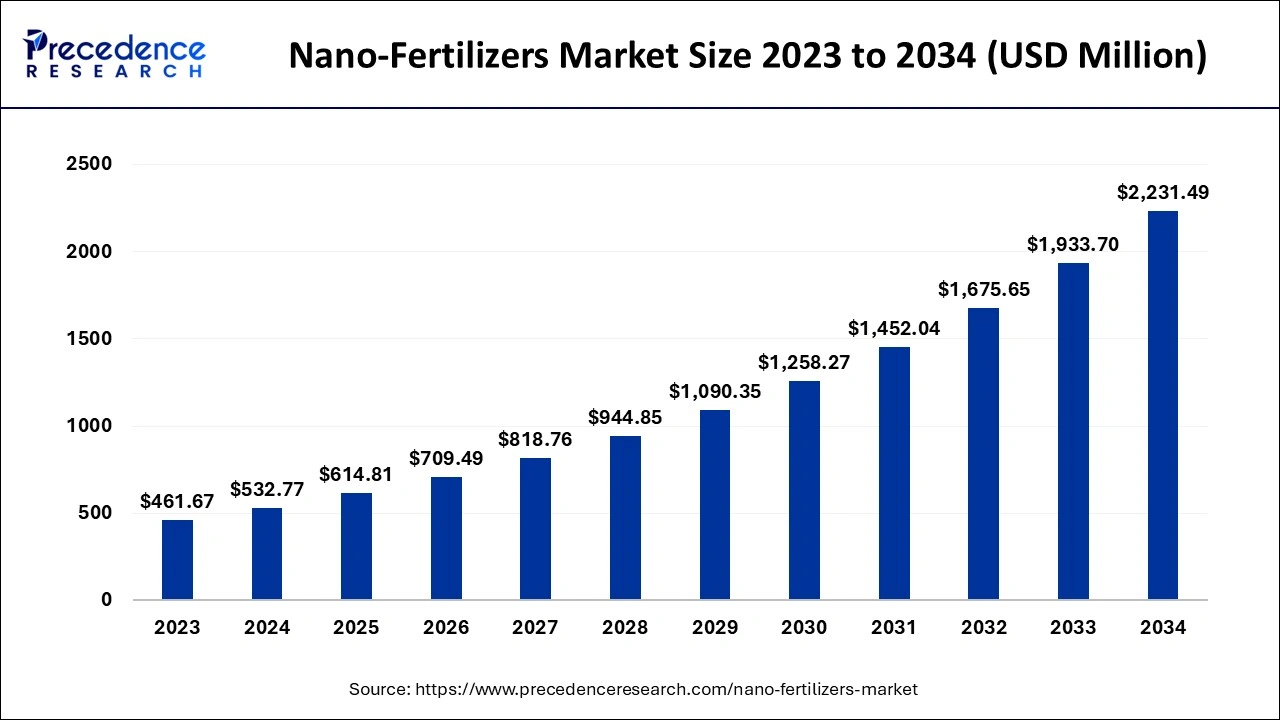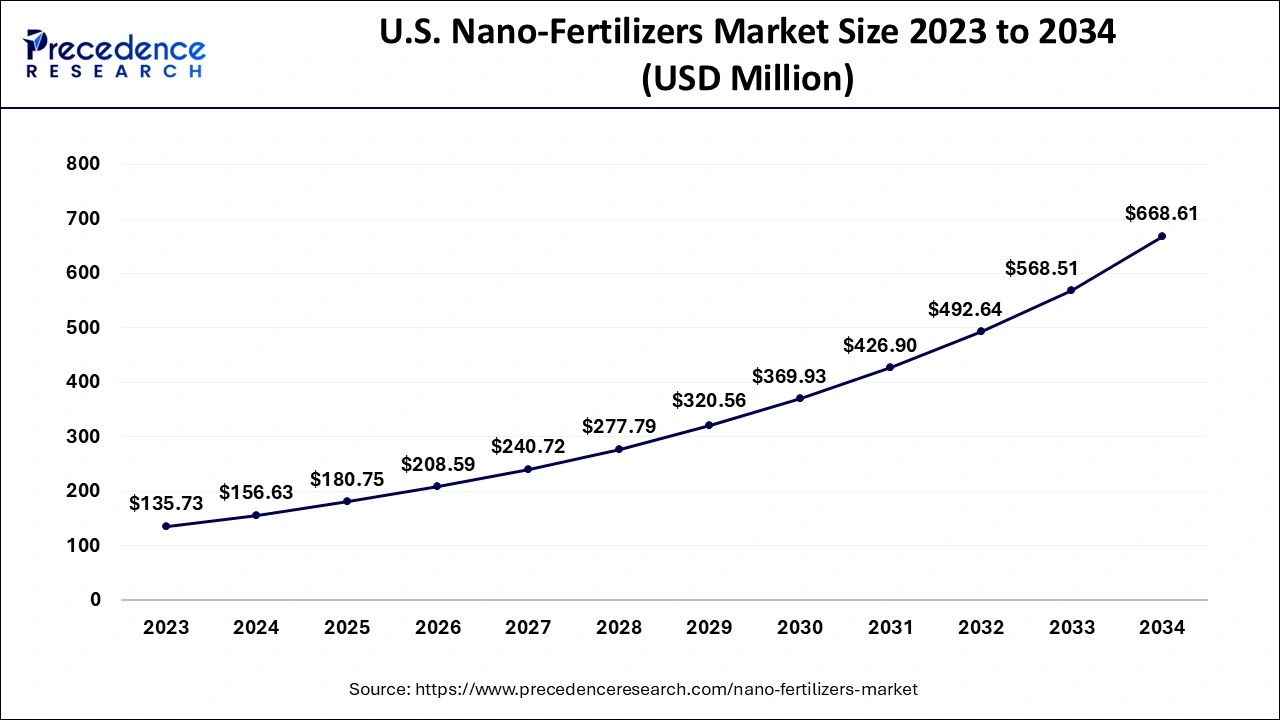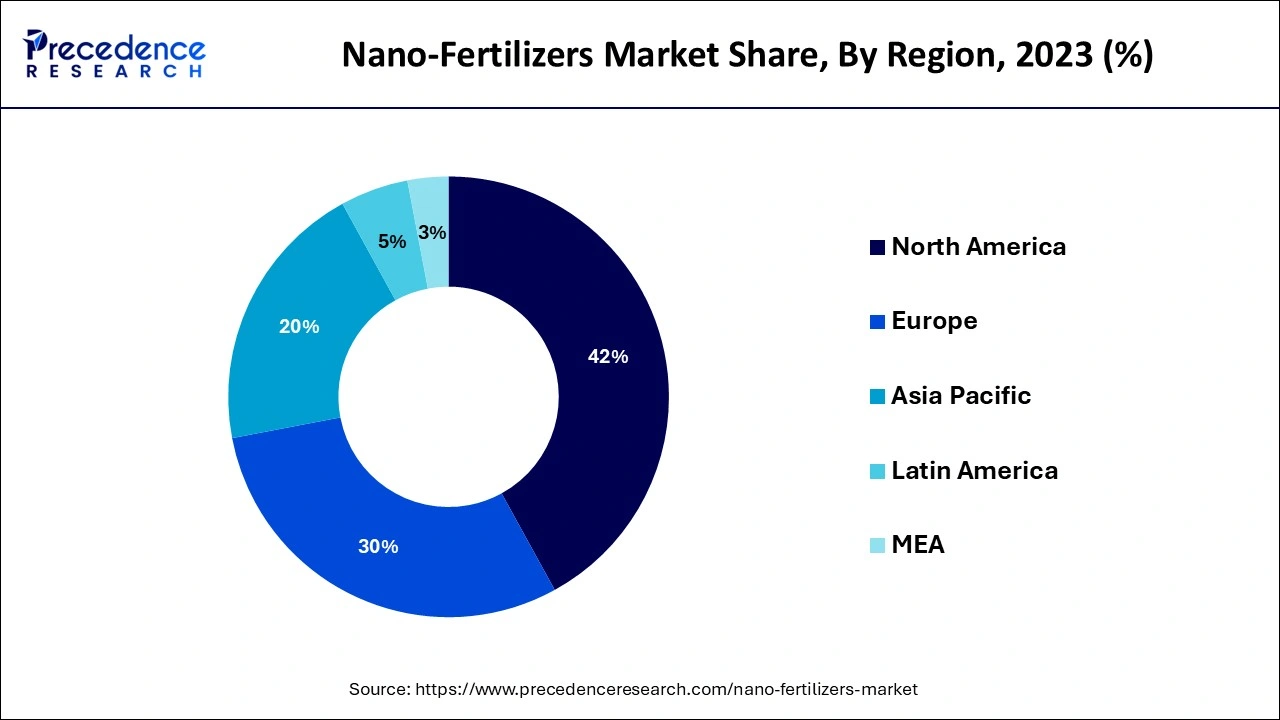Nano-Fertilizers Market Size and Forecast 2024 to 2034
The global nano-fertilizers market size is estimated at USD 532.77 million in 2024 and is anticipated to reach around USD 2231.49 million by 2034, expanding at a CAGR of 15.40% from 2024 to 2034.

Nano-Fertilizers Market Key Takeaways
- North America dominated nano-fertilizers market in 2023.
- By raw material, Carbon-based nanomaterials segment is expected to increase its market share during the forecast period.
- By category, nanoscale fertilisers segment led the market during forecast period.
U.S. Nano-Fertilizers Market Size and Growth 2024 to 2034
The U.S. nano-fertilizers market size is evaluated at USD 156.63 million in 2024 and is predicted to be worth around USD 668.61 million by 2034, rising at a CAGR of 15.60% from 2024 to 2034.

Because of advancements in agriculture in nations such as the United States and Canada, the North American area is expected to lead the global in the next five years. Furthermore, research and technical progress in the area are fast expanding, supporting the future growth of the worldwide nano fertilisers market during the next five years.

Because of their reliance on agriculture, nations such as India and China are expected to expand the quickest in the Asia Pacific area during the next five years. Agriculture produces significant cash for countries such as China, India, and Taiwan. Furthermore, growing adoption of nanotechnology in agriculture is likely to drive development in the worldwide nano fertilisers market over the next five years. Market participants are also playing a vital role in market expansion. New market companies may combine and work with existing industry giants to introduce innovative products and create brand value.
Market Overview
The global nano fertilisers market is growing rapidly due to rising demand for food crops. The rapidly rising worldwide population and the need to feed everyone will drive the expansion of the global nano fertilisers industry in the next five years.
Due to their excellent capacity to improve nutrient usage efficiency, nanofertilizers have advantages in the management of nutrition. In contrast to typical fertilisers, nutrients applied alone or in combination are bonded to nano-dimensional adsorbents, that release nutrients very gradually. This strategy reduces fertiliser loss into ground water while simultaneously improving nutrient usage efficiency. Additionally, nanofertilizers may be utilised to increase resistance to abiotic stress, and when combined with microorganisms, these so-called nanobiofertilizers provide a host of additional advantages. However, even if nanofertilizers have unquestionably opened up new avenues for sustainable agriculture, their drawbacks should also be carefully evaluated before being put on the market.
Nano-fertilizers are a combination of nanotechnology and agriculture, mostly used to improve the capabilities of fertilisers. Nano-particles are utilised to make fertilisers more easily and effectively absorbable by plants. The particles are placed to the soil or sprayed on the plants in various ways and then absorbed by the land body. Nano fertilisers are supposed to boost agricultural yields, increase plant absorbency, and supply more nutrients to plants, making them popular among customers worldwide.
The agricultural industry is one of the most important businesses that must run smoothly and efficiently. The demand for fertilisers is growing as the toxicity of the environment increases. Toxins in the soil, water, and air reduce agricultural output, limit plant development, cause toxin buildup in fruits and vegetables, and so on. As a result, demand for efficient and effective fertilisers is growing, fuelling the expansion of the worldwide nano fertilisers market during the next five years. Furthermore, the overuse of chemical fertilisers causes leaching, eutrophication, pollution, and persistent impacts in crops. The desire for switching fertilisers from chemical fertilisers to nano fertilisers is assisting the worldwide nano fertilisers market's expansion in the anticipated years, through 2033.
Nano-Fertilizers Market Growth Factors
The use of nanofertilizers can reduce the consumption of chemical fertilisers by 80-100 times, decreasing unneeded chemical fertiliser imports by a country. The demand for Nano Urea is increasing significantly throughout the world since it can replace regular Urea while giving a lower input cost, higher crop yield, and a higher charge because to the higher-quality produce. Nano Urea is expected to replace 13.7 million litres of regular urea usage over the next five years, while IFFCO has also begun testing of nano version of DAP fertilisers. It also offers a lot of advantages in terms of relative transportation and storage costs, and farmers may simply raise bottles of Nano Urea physically rather than cumbersome Urea bags. Nano Urea is a viable and long-term alternative to typical bulk nitrogenous fertilisers such as urea.
Market Scope
| Report Coverage | Details |
| Market Size in 2024 | USD 532.77 million |
| Market Size by 2034 | USD 2231.49 million |
| Growth Rate from 2024 to 2034 | CAGR of 15.40% |
| Base Year | 2023 |
| Forecast Period | 2024 to 2034 |
| Segments Covered | Category, Raw Material, Application, Method of Application, Crop Type, and Geography |
Market Dynamics
Key Market Drivers
- The capacity to replace regular urea: Nano Urea is the first liquid fertiliser of its sort, reducing the overuse of regular Urea. It was created in-house at the Nano Biotechnology Research Centre in Kalol, Gujarat, using unique patented technology. Nano Urea is a source of nitrogen, which is the primary nutrient required for the plant's proper growth and development. In a plant, nitrogen is the most abundant element of photosynthetic pigments, amino acids, enzymes, and power switch chemicals. Nitrogen concentration in a healthy plant typically ranges from 1.5 to 4%. Foliar feeding of Nano Urea effectively meets a plant's Nitrogen need at crucial crop boom levels, resulting in higher crop output and pleasantness as compared to traditional urea.
- The requirement for more production of crops due to increasing population - As the population grows, so does the demand for food. One of the most fundamental reasons for the need for agricultural productivity increase approaches is this. In agriculture, nano-products like as nano fertilisers and nano-pesticides are aimed at reducing chemical propagation, minimising nutritional losses in fertiliser, and enhancing yields through pesticide and nutrient control. As a result, new nanotools in agriculture can help to advance nanotechnology. The growing need for the best agricultural production with limited resources has given it tremendous reputation among farmers.
Key Market Challenges
- Poor quality of the products - The low quality of the nano fertilizers items is limiting market expansion. In some circumstances, the product given falls short of expectations, and the product necessary for fertilisation is unable to fulfil the nitrogen fixation process. As a result, it limits nano fertilizer market expansion.
Key Market Opportunities
Demand for nano fertilizers in agriculture is increasing
- Agriculture nanotechnology applications appear to be a viable option, promoting the transformation of traditional production systems into improved agricultural practises with a clear emphasis on the creation of more efficient and environmentally friendly approaches. Nano fertilizers might be a game changer in environmental protection since they can be administered in lower quantities than regular fertilisers, minimising leaching, runoff, and gas emissions into the atmosphere.
Supporting sustainable electrification necessities in agricultural sector
- Nano fertilizers have been projected as a tool for meeting sustainable intensification requirements in agricultural activities over the next 30 years due to the feasibility of synchronizing nutrient release mechanisms with increases in crop yields and forage production while reducing fertilization inputs.
- Nano fertilizers can increase NUE by allowing for a steady and consistent delivery of nutrients, which aids nutrient plant absorption. It has been suggested that the use of nano fertilizers can increase crop productivity by up to 30% when compared to regular chemical fertilizers; nevertheless, investigations have shown that employing nano fertilizers has no benefit over conventional fertilizers.
Category Insights
The market is further subdivided by type into nanoscale fertiliser, nanoscale additive fertiliser, and nanoscale coating fertiliser. Because of their benefits in giving nutrients in a more effective manner, nanoscale fertilisers are expected to have the greatest revenue shares of the market and exert their supremacy over the market sector in the next five years. These fertilisers are composed of nutrient-rich nanoparticles. Physical (top-down) as well as chemical (bottom-up) techniques are used to create preliminary nanomaterials. The nutrients are enclosed within a nano porous substance covered with thin polymer particles. Nanoscale fertilisers have a greater absorption capacity.
Raw Material Insights
Carbon-based nanomaterials are expected to account for the majority of market revenue due to their high absorption capacity. Graphene oxide films, a carbon-based nanomaterial, can increase the period of function and minimise leaching losses by prolonging potassium nitrate release. Silver raw material is also projected to rise significantly in the next five years due to its effectiveness in delivering green as well as eco-friendly alternatives. These raw materials have been impacted with particles which have antibacterial actions against various plant infections, as well as the ability to assist plants in improving their ability to absorb critical nutrients in the soil.
Carbon-based nanomaterials are expected to account for the majority of market revenue due to their high absorption capacity. Graphene oxide films, the carbon-based nanomaterial, can increase the period of function and minimise leaching losses by prolonging potassium nitrate release. Silver raw material is also projected to rise significantly in the next five years due to its effectiveness in delivering green as well as eco-friendly alternatives. These raw materials have been impacted with particles that have antibacterial actions against various plant infections, as well as the ability to assist plants in improving their ability to absorb critical nutrients from the soil.
Application Insights
Because of their capacity to transfer nutrients in the soil, allowing their release and penetration into the roots, soil mode of application is predicted to dominate the category and register the biggest revenue shares of the market in the next five years. Furthermore, continuous exploration of novel solutions has resulted in the creation of innovative nanomaterials, likely to result in a powerful device for the creation of modern technological products which are efficiently supplied via soil application method, continuing to support the growth of the sub-segment and driving the growth of the global nano fertilisers market in the next five years.
Nano-Fertilizers Market Top Companies
- BASF SE
- Indian Farmer Fertilizer Cooperative Limited
- Yara International ASA
- Hindustan Insecticide Limited
- Fertilizers and Chemical Travancore Ltd.
- CF Industries Holdings Inc.
- China National Petroleum Corporation
- Jiangsu same Group Co, Ltd.
- EuroChem
- Koch Fertilizer LLC
- Nutrien Ltd.
- OCI Nitrogen
- Petrobras
- Qatar Fertiliser Company
- SABIC
- Notore Chemical Industries Plc
Recent Developments
- In response to structural changes in the global energy, agricultural, and fertiliser sectors, Nutrien announced today intentions to boost fertiliser production capabilities in June 2022.
- The CP Group with Charoen Pokphand Foods Public Company Limited will launch the CPF Grow-Share-Protect Mangrove Forestation Project in Trat province, encompassing an area of 1,300 rai in 2022. The goals are to increase biodiversity, conserve animal and marine life in the region, stimulate the local economy, and, as a result, raise the standard of living for the populations that surround the mangrove areas.
Segments Covered in the Report
By Category
- Nanoscale Fertilizer
- Nanoscale Additive Fertilizer
- Nanoscale Coating Fertilizer
By Raw Material
- Silver
- Copper
- Aluminium
- Carbon
- Others
By Application
- Plastic
- Metal
- Ceramic
- Others (Wax, Laywood, Bioinks, etc.)
By Method of Application
- Soil Method of Application
- Foliar or Spray Method of Application
- Soaking Method
By Crop Type
- Cereals & Grains
- Oilseeds & Pulses
- Fruits & Vegetables
- Others
By Geography
- North America
- Europe
- Asia-Pacific
- Latin America
- Middle East & Africa (MEA)
For inquiries regarding discounts, bulk purchases, or customization requests, please contact us at sales@precedenceresearch.com
Frequently Asked Questions
Ask For Sample
No cookie-cutter, only authentic analysis – take the 1st step to become a Precedence Research client
 sales@precedenceresearch.com
sales@precedenceresearch.com
 +1 804-441-9344
+1 804-441-9344